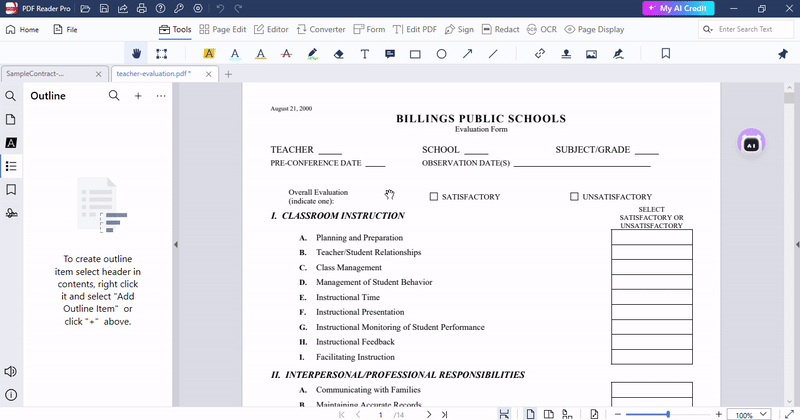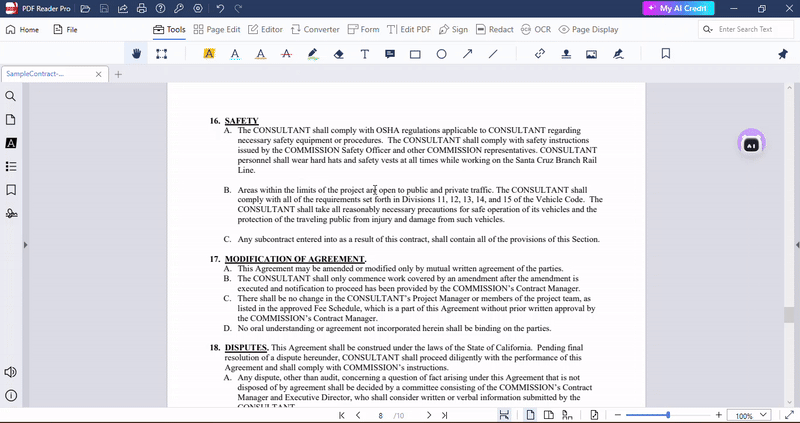Why should we make PDFs easy for everyone to use? In our world, it's important that everyone, including people with disabilities, can open, read, and move through PDF documents without trouble. PDF Reader Pro is a tool that helps make this possible. This guide will show you how to add tags to a PDF.
Tagging and Creating Outlines in PDF Reader Pro
Creating an accessible PDF document involves more than just making the content readable; it also requires making the document easy to navigate. An outline serves as a map of your document, guiding users through sections and subsections effortlessly.

Step 1: Open Your PDF Document
Launch PDF Reader Pro and open the PDF file you wish to make more accessible. This is the foundational step where all modifications begin.
Step 2: Highlight and Right-Click to Select the Desired Heading
Navigate through your document to find the text you want to use as a heading for an outline section. Highlight this text, then right-click on it. This action will bring up a context menu with various options.
Step 3: Scroll Down to "Add Outline Item"
In the context menu that appears after right-clicking the highlighted text, look for an option labeled "Add Outline Item" or similar. Select this option to start the process of creating a new outline entry based on the highlighted text.
Step 4: Promote or Demote Headings to Create Main Sections and Subsections
Once you’ve added an outline item, PDF Reader Pro allows you to organize your document's structure further by promoting or demoting headings. This feature lets you designate the hierarchy of your content, setting main sections and subsections according to the document's layout.

Step 5: Remove Unnecessary Headings
If you find that an outline item is no longer needed or was added by mistake, PDF Reader Pro provides the option to remove these headings from the outline. This step is crucial for keeping your document’s navigation clean and intuitive.
Step 6: Save Your Work
After you have organized your outlines, ensuring they accurately represent the document's structure, save your work. This final step updates your PDF with the newly added or adjusted outlines, solidifying the improvements made to the document’s accessibility.
Creating Bookmarks in PDF Reader Pro
Bookmarks in a PDF serve as navigational aids, making it much simpler for readers to find and jump to specific parts of the document. This feature is particularly beneficial in longer documents, such as reports, manuals, or books, where quickly accessing particular sections can greatly enhance the reading experience.

Step 1: Access the Tools Panel
Start by opening your PDF document in PDF Reader Pro. Once open, navigate to the "Tools" panel, which is usually located at the top or side of the application window. This panel houses various tools and features that can enhance your PDF document.
Step 2: Navigate to the Desired Page
Scroll through your PDF document to locate the specific page you wish to bookmark. This could be the beginning of a chapter, a crucial section, or any part of the document you believe readers will want to return to frequently.
Step 3: Click the Bookmark Icon
Within the "Tools" panel, find and click on the "Bookmark" icon. This action may immediately create a new bookmark for the page you are currently viewing, or it might open the bookmarks panel if it wasn't already displayed.
Step 4: Locate Your Bookmark in the Bookmark Panel
After clicking the bookmark icon, your new bookmark will appear in the bookmarks panel. This panel typically lists all bookmarks in the document, providing a clear overview of the document's structure from the bookmarks' perspective.
Step 5: Rename Your Bookmark
By default, PDF Reader Pro might name your bookmark using text from the bookmarked page or simply label it with a generic name. To rename the bookmark for easier identification, right-click on the new bookmark in the bookmarks panel and select the "Rename" option. Enter a descriptive name that clearly indicates the content or section the bookmark refers to.
Step 6: Organize Your Bookmarks
If you have multiple bookmarks, you may want to organize them in a way that makes sense for your document’s structure. This could involve creating a hierarchy of main sections and subsections. Drag and drop bookmarks within the panel to rearrange their order, or use right-click options to create nested bookmarks under more general headings.
Step 7: Save Your Document
After creating and organizing your bookmarks, save your document. This will ensure that all the bookmarks you've added will be preserved and accessible to anyone who opens the document in the future.
Importance of tagging in PDF accessibility
Why Tagging Matters
Tagging is essential for making PDF documents accessible. These invisible markers guide screen readers, allowing them to understand the document's layout. This capability is vital for individuals with visual impairments, as it enables them to listen to and navigate the document effectively.
Improving Screen Reader Experience
Tags serve as signposts for screen readers, identifying different elements like headings, paragraphs, lists, tables, and images. This organization lets screen readers interpret and announce the content appropriately, offering a coherent experience rather than a jumbled stream of text.
Enhancing Navigation for Everyone
Tagging isn't just about compliance or supporting assistive technologies; it's about enhancing the document's usability for all users. It supports interactive tables of contents for quick section access and ensures the document can be reflowed for reading on smaller screens, improving the overall user experience.

Ensuring Document Usability Across Platforms
The presence of tags in a PDF makes it more versatile. It allows for the text to be exported and used in different ways, such as for translation or in other formats, ensuring that the document is not only accessible but also usable across various platforms and by a diverse audience.
Common Accessibility Issues in PDF Documents
- Lack of Tags: One of the most common issues is the absence of tags in a PDF document. Without tags, screen readers cannot interpret the structure or order of content correctly, making it difficult for users with visual impairments to understand and navigate the document.
- Missing Alternative Text for Images: When images in a PDF do not have alternative text, users who rely on screen readers miss out on important information. Alternative text describes the image content, ensuring that all users have access to the information conveyed by visuals.
- Improper Reading Order: Even if a document is tagged, an incorrect reading order can significantly impair accessibility. The reading order is what tells assistive technologies in which sequence to present the content. If the reading order is not logical or sequential, it can confuse users and disrupt their understanding of the document.








 Free Download
Free Download  Free Download
Free Download 





 Support Chat
Support Chat